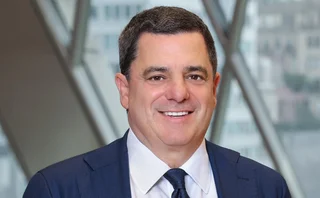
Buy-side quant of the year: Alex Lipton and Marcos Lopez de Prado
Risk Awards 2021: optimal trading solution was inspired by concept used in nuclear cooling

Systematic traders who rely on mean-reversion strategies need quantitative tools to alert them when it’s time to pull out of a trade. The problem of estimating stop-loss and profit-taking levels is normally solved by two separate models using the circuitous route of Monte Carlo simulations. But work published this year by Alex Lipton and Marcos Lopez de Prado takes a novel, more direct tack.
Perhaps appropriately for two quants who have chalked up impressive careers on opposite sides of the buy/sell divide – Lipton mostly in banking and Lopez de Prado in investment management – the pair tackle both ends of the problem of optimal trading simultaneously. Their technique adopts a closed-form solution that detects both stop-loss and profit-taking boundaries – and makes more realistic assumptions.
They deploy so-called heat potentials – a mathematical physics concept rarely used in finance and more typically applied to thermodynamics problems, notably in Russia, where its principles help cool nuclear reactors.
“This is classic Lipton and the Russian school of maths and mathematical physics,” says Michael Sotiropoulos, managing director in the quantitative research team of Citadel Securities’ market-making arm.
“The technique is general and powerful, so it can be used for seemingly disconnected problems in finance, like pricing an American option or solving mean-reverting optimal statistical arbitrage strategies,” says Sotiropoulos. “It is an elegant and robust solution.”
In their paper, they build a model to optimise the Sharpe ratio. With that, they confirm some intuitive rules of thumb for trading in a mean-reverting market. For example, when there is perception of a strong mispricing, it is advisable to hold the position rather than stopping the loss early, but if the mispricing is weak or non-existent, it is advisable to take the profit as it arises.
“This is a critical problem, particularly to market-makers that try to profit from intraday price oscillations around an equilibrium price,” says Lopez de Prado. “It’s to everybody’s advantage to have more market liquidity, and our hope is that this work will help market-making operations to be more efficient and avoid unnecessary losses,” he adds.
Solving profit-taking and stop-loss problems simultaneously is like solving a corridor problem that looks at the probability that something following a random walk falls off to the left before it falls off to the right, with the difference that the boundaries of the corridor are not constant, but time-varying.
“Other authors have tried to tackle this problem, but they did it in a rather unsatisfactory way,” says Lopez de Prado. “They adopted narrow and unrealistic assumptions. For example, some assumed that traders can hold positions indefinitely.”
Industry odd couple
When the notion to work on these models arose, Lipton and Lopez de Prado barely knew one another. Lipton was reading a chapter of a book in which Lopez de Prado proposed a numerical method to determine the exit levels of a trading strategy – and in the same chapter suggested an analytical, closed-form solution existed, but was yet to be found. Lipton’s intuition linked that problem to a physics solution he’d learned decades earlier and contacted Lopez de Prado to propose collaborating on it.
At first glance, they may seem an unlikely team. Lipton, co-founder and chief information officer of payments firm SilaMoney, is best known for his quantitative research roles on the sell side. When he became Risk.net’s first quant of the year in 2000, he was director of quant analysis at Deutsche Bank.

Ken Griffin later hired him to head capital structure quant research at Citadel, but his longest tenure was with Merrill Lynch, first as co-head of the global quant group, then as head quant at Bank of America. Since leaving banking, he has dedicated most of his efforts studying blockchain technologies and cryptocurrencies.
Lopez de Prado is global head of quantitative research and development at the Abu Dhabi Investment Authority. He latterly developed machine learning solutions at US-based hedge fund AQR and contributed to connecting quantum computing and finance.
He has spent most of his career on the buy side – heading quant equity research at UBS in Zurich, working on high-frequency trading at Citadel, heading global quantitative research at Tudor Investments and managing a team handling a $13 billion corporate bond portfolio at Guggenheim Partners.
Despite their largely diverging career paths, both talk proudly of their collaborations with US National Laboratories – Lipton at Los Alamos, Lopez de Prado at Lawrence Berkeley – as well as their numerous academic affiliations. They are convinced these experiences helped shape their scientific approach to finance and of the benefits of sharing the results of their research. The number of scientific publications between them is in the hundreds.
Their collaboration continues. Having completed a Covid-prompted epidemiological model together, they plan to solve more financial problems. “We will be working on a number of buy-side problems related to portfolio selection and extraction of value from datasets,” says Lipton
“In essence, we’ll work on incorporating the principle of the scientific method in investment management,” adds Lopez de Prado. “Where we don’t have the luxury of experimentation.”
Only users who have a paid subscription or are part of a corporate subscription are able to print or copy content.
To access these options, along with all other subscription benefits, please contact info@risk.net or view our subscription options here: http://subscriptions.risk.net/subscribe
You are currently unable to print this content. Please contact info@risk.net to find out more.
You are currently unable to copy this content. Please contact info@risk.net to find out more.
Copyright Infopro Digital Limited. All rights reserved.
As outlined in our terms and conditions, https://www.infopro-digital.com/terms-and-conditions/subscriptions/ (point 2.4), printing is limited to a single copy.
If you would like to purchase additional rights please email info@risk.net
Copyright Infopro Digital Limited. All rights reserved.
You may share this content using our article tools. As outlined in our terms and conditions, https://www.infopro-digital.com/terms-and-conditions/subscriptions/ (clause 2.4), an Authorised User may only make one copy of the materials for their own personal use. You must also comply with the restrictions in clause 2.5.
If you would like to purchase additional rights please email info@risk.net
More on Awards
Collateral management and optimisation product of the year: CloudMargin
Delivering the modern blueprint for enterprise collateral resilience
Flow market-maker of the year: Citadel Securities
Risk Awards 2026: No financing; no long-dated swaps? “No distractions,” says Esposito
Pricing and analytics: fixed income – Quantifi
Quantifi delivers high-performance, transparent and adaptable pricing and risk analytics for fixed income and credit markets
Derivatives house of the year: Citi
Risk Awards 2026: Rev up, RWAs down, as US bank gets back on track (with added XiNG and XiP)
Technology vendor of the year: SS&C Algorithmics
Risk Awards 2026: From cloud, to chips, to maths tricks – vendor getting more out of existing tech
SS&C Algorithmics: winner’s interview with Curt Burmeister
SS&C Algorithmics wins three categories in this year’s Markets Technology Awards in addition to Technology vendor of the year at the Risk Awards
Best vendor for system support and implementation: Murex
Murex wins Best vendor for system support and implementation at the Markets Technology Awards 2026
Pricing and analytics: cross-asset and structured – Murex
Murex wins Pricing and analytics: cross-asset and structured at the Markets Technology Awards 2026 thanks to its MX.3 platform







